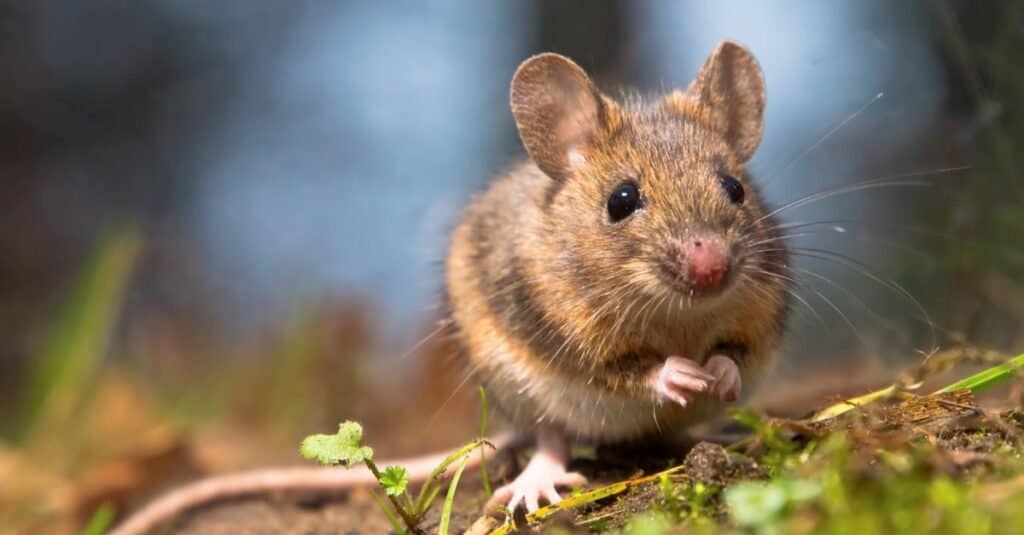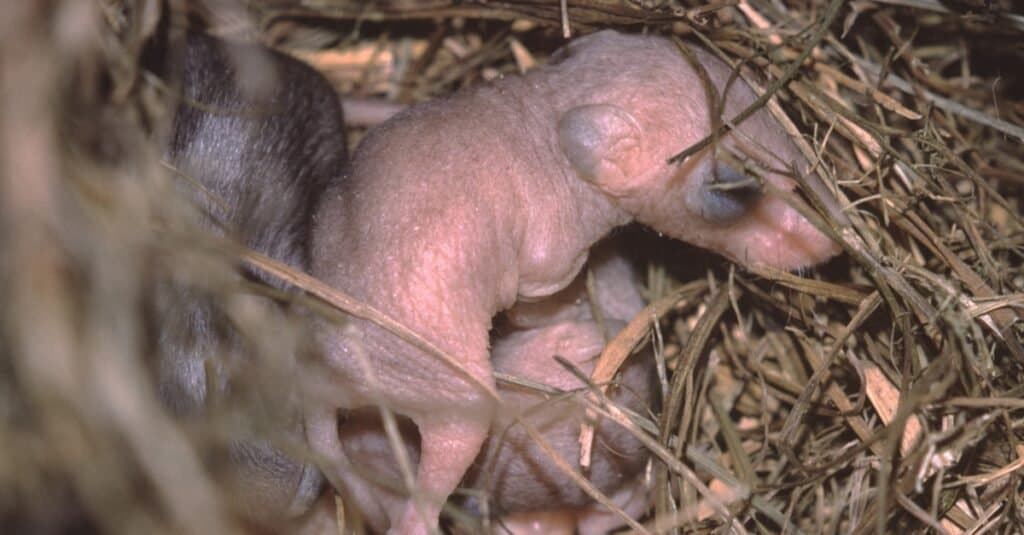Most people have heard the nursery rhyme featuring three blind mice and the cruel farmer’s wife that leaves them without tails. The song seems oddly specific in its subject matter. That only makes it fair to ask, are there really blind mice? We’re going to consider the question, talk about when mice can be blind, and get to the bottom of the matter.
The Ways Mice Perceive the World

Mice use their whiskers to help them feel around their environment.
©iStock.com/CreativeNature_nl
Mice do not have the same acuity in their visual sense as human beings. That should not come as much of a surprise, though. They have very small eyes, after all. Many different animals have various levels of senses that they use to interact with the world around them. Mice are no different. They make use of their best senses to survive in a world that can be very hostile to them.
Like other mammals, they have a good sense of touch. In fact, it’s believed that mice greatly rely on their sense of touch to perceive the world around them. Mice move their whiskers around to touch their environment as humans would feel with their fingers. They use that input to sense what’s around them even when they’re in complete darkness.
Mice also rely on their keen sense of hearing to figure out what is around them. This is especially useful in trying to hear the presence of predators. Some species of mice use their hearing as a form of echolocation, but we’ll get back to that later in this article.
Lastly, mice have a very good sense of smell. This helps them find food and stay out of areas where predators are lingering.
How Mice See the World
As you probably noticed, we didn’t mention a mouse’s sense of vision. That’s because mice don’t have a great sense of vision. That doesn’t make them blind, though. They have eyes that function, but they certainly don’t have the visual acuity of humans or a hawk.
Mice are very near-sighted, only capable of focusing on objects just a foot or two in front of them. They can see much farther than that, but with less detail.
Moreover, it’s believed that mice can’t see things with the same complexity as humans. They can see the shape and orientation of a piece of furniture, but fine details are lost on them. Now that we know how mice perceive the world, let’s focus on our initial question.
Are There Really Blind Mice?

Baby mice are born blind.
©Liz Weber/Shutterstock.com
Yes, there are blind mice. However, like so many other questions in the animal world, this answer is not cut and dry. Some mice are functionally blind. Other mice are blind for a short time. Sometimes, mice are believed to be blind because of their poor vision. We need to dig a lot deeper into this question to flesh out the truth of the matter.
How Can Mice Be Truly Blind?
Mice can be blind in two different ways. The first situation in which mice can be blind is when they are first born. For the first 20 days of their lives, baby mice are blind and hairless. Only after that time do they open their eyes and begin to perceive the world around them.
In that sense, there are blind mice, and they are very common. However, they grow up quickly and they are capable of sight.
Of course, mice can also become blind through injuries, birth defects, and aging. Again, that doesn’t have any bearing on the creatures as a whole.
Functionally Blind Mice
Most species of mice have a relatively poorly developed sense of sight. They can neither see well nor far away. They have very small eyes and other senses that are much more useful to them. After all, sight doesn’t always help in the dark, enclosed spaces that mice seek out.
When you add in the fact that mice are mostly nocturnal, it’s clear that sight is not always the sense they get the most from using.
Although all mice aren’t blind, some of them are functionally blind. In other words, they barely use their sense of sight because it is so poorly developed. The Chinese pygmy dormouse is one example of a mouse that doesn’t rely on its sight to find its way around.
According to recent studies, this species is one of the few types of mammals that uses echolocation to find its way around in low-light settings. If you look at these mice, it’s clear that vision is not quite their thing. They have incredibly small eyes and live in the forests of China and Vietnam.
These mice are best described as functionally blind. They have a poor ability to focus their sight due to their visual organs being underdeveloped for the task. It’s believed that they can tell the difference between light and dark but not much else.
How Do Blind Mice Find Their Way?

Mice use their smell, touch, and hearing to find their way around the world.
©Rudmer Zwerver/Shutterstock.com
When mice lack good vision, they rely on their other senses to pick up the slack and help them perceive the world. In most cases, you’ll find that mice rely on their senses of touch and hearing to guide them where they need to be. Their sense of smell is also critical to finding their way to food.
Interestingly, the Chinese pygmy dormouse has another way of sensing the world around it: echolocation. These mice use ultrasonic squeaks to locate obstacles in their path and navigate around them. This is the same general concept of what bats do to help them find their way in the world.
Generally speaking, though, mice use all their other senses to find their way, avoid danger, and survive. They are well-adapted to the darkness that they spend much of their time living in.
Are there really blind mice? Yes, but not completely and not always. You’re not likely to run into many blind mice in your life. If a mouse happens to be traveling in your direction, it may have felt cornered by you. Otherwise, they probably have not realized that you’re a large mammal yet. They typically avoid humans at all costs, so you can leave the carving knife in the kitchen.
In any case, blind mice are around, but not common at all.
The photo featured at the top of this post is © iStock.com/artisteer
Thank you for reading! Have some feedback for us? Contact the AZ Animals editorial team.







